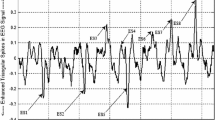Abstract
This Paper presents an automated method of Epileptic Spike detection in Electroencephalogram (EEG) using Deterministic Finite Automata (DFA). It takes pre-recorded single channel EEG data file as input and finds the occurrences of Epileptic Spikes data in it. The EEG signal was recorded at 256 Hz in two minutes separate data files using the Visual Lab-M software (ADLink Technology Inc., Taiwan). It was preprocessed for removal of baseline shift and band pass filtered using an infinite impulse response (IIR) Butterworth filter. A system, whose functionality was modeled with DFA, was designed. The system was tested with 10 EEG signal data files. The recognition rate of Epileptic Spike as on average was 95.68%. This system does not require any human intrusion. Also it does not need any short of training. The result shows that the application of DFA can be useful in detection of different characteristics present in EEG signals. This approach could be extended to a continuous data processing system.



Similar content being viewed by others
References
Agarwal, R., and Gotman, J., Computer-assisted sleep staging. IEEE Trans BME. 48:1412–23, 2001.
Litt, B., and Echauz, J., Prediction of epileptic seizures. Lancet Neurol. 1:22–30, 2002.
Paivinen, N., Lammi, S., Pitkanen, A., Nissinen, J., Penttonen, M., and Gronfors, T., Epileptic seizure detection: A nonlinear viewpoint. Computer Methods and Programs in Biomedicine. 79:151–159, 2005.
Liu, A., Hahn, J. S., Heldt, G. P., and Coen, R. W., Detection of neonatal seizures through computerized EEF analysis. Electroencephalogr. Clin. Neurophysiol. 82:30–37, 1992.
Gotman, J., Flanagah, D., Zhang, J., and Rosenblatt, B., Automatic seizure detection in the newborn: Methods and initial evaluation. Electroencephalogr. Clin. Neurophysiol. 103:356–362, 1997.
Adeli, H., Zhou, Z., and Dadmehr, N., Analysis of EEG records in an epileptic patient using wavelet transform. J. Neurosci. Methods. 123:69–87, 2003.
Khan, Y. U., and Gotman, J., Wavelet based automatic seizure detection in intracerebral electroencephalogram. Clin. Neurophysiol. 114:898–908, 2003.
Zarjam, P., Mesbah, M., and Boashash, B., Detection of newborns EEG seizure using optimal features based on discrete wavelet transform. Proceedings of the IEEE International Conference on Acoustics Speech and Signal Processing. 2:265–268, 2003.
Subasi, A., Epileptic seizure detection using dynamic wavelet network. Expert Syst. Appl. 29:343–355, 2005.
Subasi, A., EEG signal classification using wavelet feature extraction and a mixture of expert model. Expert Syst. Appl. 32:1084–1093, 2007.
Ocak, H., Automatic detection of epileptic seizures in EEG using discrete wavelet transform and approximate entropy. doi:10.1016/j.eswa.2007.12.065. 2008.
Webber, W. R. S., Lesser, R. P., Richardson, R. T., and Wilson, K., An approach to seizure detection using an artificial neural network (ANN). Electroencephalogr. Clin. Neurophysiol. 98:250–272, 1996.
Petrosian, A., Prokhorov, D., Homan, R., Dashei, R., and Wunsch, D., Recurrent neural network based prediction of epileptic seizures in intra- and extracranial EEG. Neurocomputing. 30:201–218, 2000.
Sinha, R. K., Backpropagation artificial neural network to detect hyperthermic seizures in rats. Online Journal of Health and Allied Sciences. 4:1, 2002.
Kiymik, M. K., Akin, M., and Subasi, A., Automatic recognition of alertness level by using wavelets transform and artificial neural network. J. Neurosci. Methods. 139:231–240, 2004.
Sinha, R. K., Ray, A. K., and Agrawal, N. K., An artificial neural network to detect EEG seizures. Neurol. India. 52:399–400, 2004.
Subasi, A., Automatic detection of epileptic seizure using dynamic fuzzy neural networks. Expert Syst. Appl. 31:320–328, 2006.
Hafner, U., Albert, J., Frank, S., and Unger, M., Weighted Finite Automata for Video Compressing. IEEE J. Sel. Areas Commun. 16:108–119, 1998.
Yalcin, A., and Boucher, T. O., Deadlock Avoidance in Flexible Manufacturing Systems Using Finite Automata. IEEE Trans. Robot. Autom. 16:424–429, 2000.
El-Din, S. N., and Moniri, M., Image authentication using generalized finite automata. IEE Proc. – Vis. Image Signal Process. 153:493–500, 2006.
Yeol, J. W., Barjis, I. Y., and Ryu, S., Modeling of System Biology from DNA to by Automata Networks. Proceedings of ICISIP. 523–528, 2005.
Sinha, R. K., Electroencephalogram disturbances in different sleep-wake states following exposure to high environmental heat. Med. Biol. Eng. Comput (IEE). 42:282–287, 2004.
Sarbadhikari, S. N., A Neural network confirms that physical exercise reverses EEG changes in depressed rats. Med. Eng. Phy. 17:579–582, 1995.
Sinha, R. K., Artificial neural network detects changes in electro-encephalogram power spectrum of different sleep-wake states in an animal model of heat stress. Med. Biol. Eng. Comput (IEE). 41:595–600, 2003.
Hopcroft, J. E., and Ullman, J. D., Introduction to Automata Theory, Languages and Computation. Addison-Wesley Publishing Company USA, 1979.
Pappadimitriau, C. H., and Lewis, H. R., Elements of the Theory of Computation, 2nd Edn. Pearson Education India, 2001.
Mishra, K. L. P., and Chandrasekaran, N., Theory of Computer Science Automata, Languages and Computation, 3rd edition. Prentice-Hall of India, New Delhi, 2007.
Gotman, J., Ives, J. R., and Gloor, P., Long-term Monitoring in Epilepsy. Electroenceph. Clin. Neurophysiology, Suppl., Elsevier, Amsterdam. 37:133–145, 1985.
Gotman, J., Automatic seizure detection: improvements and evaluations. Electroenceph. Clin. Neurophysiology. 76:317–324, 1990.
Mirbagheri, M. M., Badie, K., Golpayegani, R. M. H., and Ahmadi, M. A., A neural Network approach to EEG classification for the purpose pf different diagnosis between epilepsy and normal EEG. In: Proc. 14th Annual International Conference IEEE Engineering in Medicine and Biology Society, IEEE, New York. 2649–2650, 1992.
Jando, G., Siegel, R. M., Horwath, Z., and Buzsaki, G., Pattern recognition of the electroencephalogram by artificial neural networks. Electroencephalogr. Clin. Neurophysiol. 86:100–109, 1993.
Author information
Authors and Affiliations
Corresponding author
Additional information
Certificate of Originality
This is to certify that the article submitted for publication in ‘Journal of Medical Systems’ has not been published, nor is being considered for publication, elsewhere. All experimental procedures on rats were performed in compliance with “Committee for the purpose of control and supervision of experiments on animals (CPCSEA)”, India.
Rights and permissions
About this article
Cite this article
Kumar Keshri, A., Kumar Sinha, R., Hatwal, R. et al. Epileptic Spike Recognition in Electroencephalogram Using Deterministic Finite Automata. J Med Syst 33, 173–179 (2009). https://doi.org/10.1007/s10916-008-9177-1
Received:
Accepted:
Published:
Issue Date:
DOI: https://doi.org/10.1007/s10916-008-9177-1




